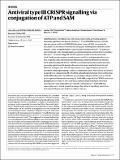Files in this item
Antiviral type III CRISPR signalling via conjugation of ATP and SAM
Item metadata
| dc.contributor.author | Chi, Haotian | |
| dc.contributor.author | Hoikkala, Ville Petteri | |
| dc.contributor.author | Gruschow, Sabine | |
| dc.contributor.author | Graham, Shirley | |
| dc.contributor.author | Shirran, Sally Lorna | |
| dc.contributor.author | White, Malcolm | |
| dc.date.accessioned | 2023-10-19T16:30:07Z | |
| dc.date.available | 2023-10-19T16:30:07Z | |
| dc.date.issued | 2023-10-26 | |
| dc.identifier | 293953798 | |
| dc.identifier | b2453e59-1c79-41e3-9192-516d29926dfe | |
| dc.identifier | 85174388315 | |
| dc.identifier.citation | Chi , H , Hoikkala , V P , Gruschow , S , Graham , S , Shirran , S L & White , M 2023 , ' Antiviral type III CRISPR signalling via conjugation of ATP and SAM ' , Nature , vol. 622 , no. 7984 , pp. 826-833 . https://doi.org/10.1038/s41586-023-06620-5 | en |
| dc.identifier.issn | 0028-0836 | |
| dc.identifier.other | ORCID: /0000-0003-3516-3507/work/145030947 | |
| dc.identifier.other | ORCID: /0000-0003-1543-9342/work/145031132 | |
| dc.identifier.other | ORCID: /0000-0002-2608-3815/work/160753802 | |
| dc.identifier.uri | https://hdl.handle.net/10023/28552 | |
| dc.description | Funding: This work was supported by grants from the Biotechnology and Biological Sciences Research Council (Grant BB/T004789/1 to M.F.W.) and European Research Council (ref. 101018608 to M.F.W.). H.C. acknowledges the support of the China Scholarship Council (code 202008420207). V.H. is funded by the Finnish Cultural Foundation. | en |
| dc.description.abstract | CRISPR systems are widespread in the prokaryotic world, providing adaptive immunity against mobile genetic elements1,2. Type III CRISPR systems, with the signature gene cas10, use CRISPR RNA to detect non-self RNA, activating the enzymatic Cas10 subunit to defend the cell against mobile genetic elements either directly, via the integral histidine–aspartate (HD) nuclease domain3,4,5 or indirectly, via synthesis of cyclic oligoadenylate second messengers to activate diverse ancillary effectors6,7,8,9. A subset of type III CRISPR systems encode an uncharacterized CorA-family membrane protein and an associated NrN family phosphodiesterase that are predicted to function in antiviral defence. Here we demonstrate that the CorA-associated type III-B (Cmr) CRISPR system from Bacteroides fragilis provides immunity against mobile genetic elements when expressed in Escherichia coli. However, B. fragilis Cmr does not synthesize cyclic oligoadenylate species on activation, instead generating S-adenosyl methionine (SAM)-AMP (SAM is also known as AdoMet) by conjugating ATP to SAM via a phosphodiester bond. Once synthesized, SAM-AMP binds to the CorA effector, presumably leading to cell dormancy or death by disruption of the membrane integrity. SAM-AMP is degraded by CRISPR-associated phosphodiesterases or a SAM-AMP lyase, potentially providing an ‘off switch’ analogous to cyclic oligoadenylate-specific ring nucleases10. SAM-AMP thus represents a new class of second messenger for antiviral signalling, which may function in different roles in diverse cellular contexts. | |
| dc.format.extent | 22 | |
| dc.format.extent | 33820952 | |
| dc.language.iso | eng | |
| dc.relation.ispartof | Nature | en |
| dc.subject | QH301 Biology | en |
| dc.subject | QR355 Virology | en |
| dc.subject | DAS | en |
| dc.subject | MCC | en |
| dc.subject.lcc | QH301 | en |
| dc.subject.lcc | QR355 | en |
| dc.title | Antiviral type III CRISPR signalling via conjugation of ATP and SAM | en |
| dc.type | Journal article | en |
| dc.contributor.sponsor | BBSRC | en |
| dc.contributor.sponsor | European Research Council | en |
| dc.contributor.institution | University of St Andrews. St Andrews Bioinformatics Unit | en |
| dc.contributor.institution | University of St Andrews. Biomedical Sciences Research Complex | en |
| dc.contributor.institution | University of St Andrews. School of Biology | en |
| dc.contributor.institution | University of St Andrews. Institute of Behavioural and Neural Sciences | en |
| dc.identifier.doi | 10.1038/s41586-023-06620-5 | |
| dc.description.status | Peer reviewed | en |
| dc.identifier.grantnumber | BB/T004789/1 | en |
| dc.identifier.grantnumber | 01018608 | en |
This item appears in the following Collection(s)
Items in the St Andrews Research Repository are protected by copyright, with all rights reserved, unless otherwise indicated.

